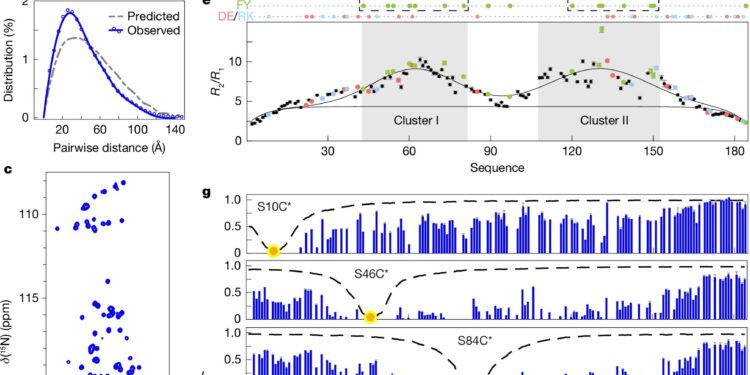Hydrophobic clustering in ER-NTD. Credit: Nature (2025). DOI: 10.1038/s41586-024-08400-1
Researchers at Case Western Reserve University School of Medicine have discovered how specific protein regions contribute to breast cancer. Their study, recently published in Naturefocuses on the so-called estrogen receptor, a protein linked in previous research to the development of about 70 percent of all breast tumors.
Just as a machine needs specific controls to function, proteins like the estrogen receptor control cell growth and behavior.
“We discovered previously unknown ‘molecular switches’ within the estrogen receptor that, although flexible, work together with remarkable precision to coordinate cellular processes,” said Sichun Yang, associate professor of nutrition at the School of Medicine and member of the Case Comprehensive Cancer Center.
“Changing part of the protein can trigger a chain reaction that affects the growth of breast cancer cells.”
Although further research is needed to eventually use their results to develop new treatments, this discovery offers scientists new tools and ideas far beyond breast cancer, as similar protein regions are involved in many other diseases.
Breast cancer is the most commonly diagnosed cancer worldwide, with more than 2.3 million new cases and 670,000 deaths reported in 2022, according to the World Health Organization. Despite the initial effectiveness of drugs targeting estrogen receptors, many patients eventually develop resistance, rendering the therapies ineffective. This new discovery could lead to more effective treatments and help explain why this might be happening.
“Instead of simply turning off the estrogen receptor,” Yang said, “future drugs could be designed to target these newly discovered switches, providing new ways to control how the protein works.”
The research team used small-angle X-ray scattering and nuclear magnetic resonance spectroscopy tools from Argonne National Laboratory’s Advanced Photon Source and the National Synchrotron Light Source II to study protein switches with extraordinary details. The collaboration included researchers from Arizona State University and Ohio State University. Additional support came from the National Institutes of Health, the American Cancer Society and the Mary Kay Ash Foundation.
“Yang’s work highlights the importance of using cutting-edge technology and teamwork to answer big scientific questions,” said Mark Chance, director of the School’s Center for Proteomics and Bioinformatics. of medicine. “These national facilities allow us to make breakthroughs that can lead to new cancer treatments.”
More information:
Zhanwen Du et al, The sequence-structure-function relationship of intrinsic disorder ERα, Nature (2025). DOI: 10.1038/s41586-024-08400-1
Provided by Case Western Reserve University
Quote: Discovery of estrogen receptor ‘switches’ could aid treatment of breast cancer (January 14, 2025) retrieved January 14, 2025 from
This document is subject to copyright. Except for fair use for private study or research purposes, no part may be reproduced without written permission. The content is provided for informational purposes only.



